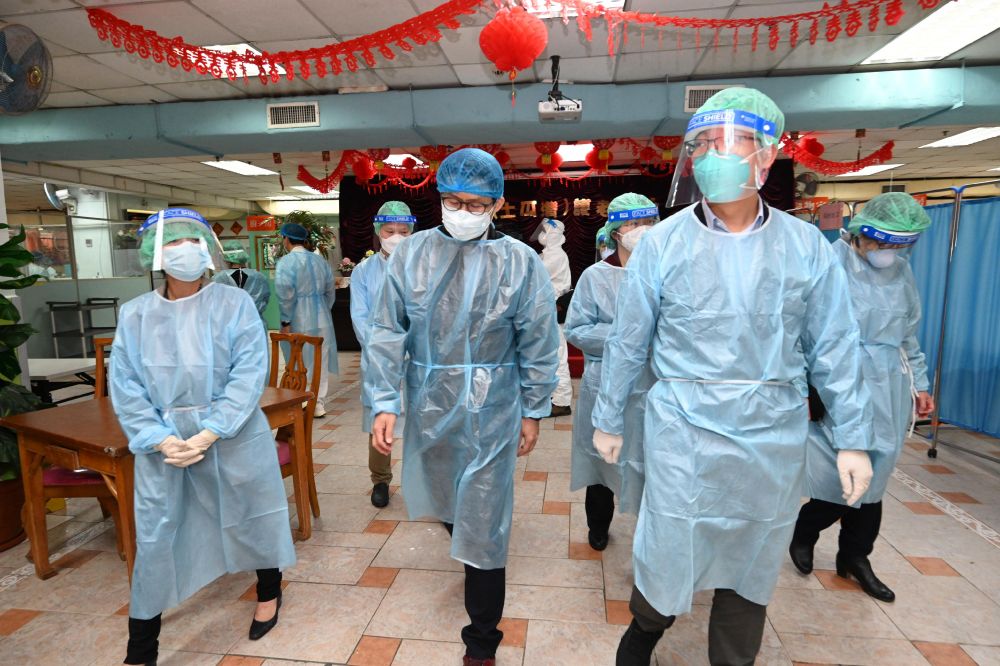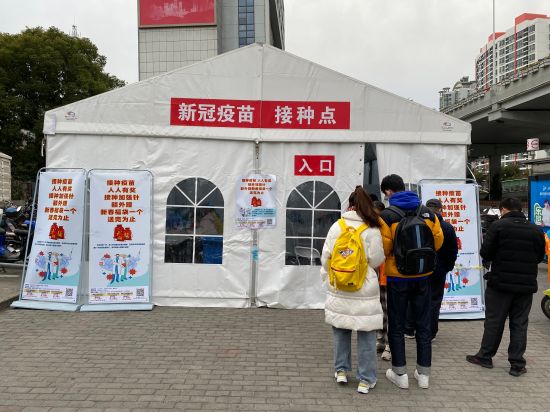The sharp rise in Covid-19 cases in China due to the wave of Omicron variant infections is forcing the mainland to shift from its zero-Covid approach to a more flexible, targeted strategy, writes Yuen-ying Chan of The University of Hong Kong. With Hong Kong as an abject lesson of the perils of clinging to an out-of-date strategy, China faces difficult weeks and months in its struggle to get to the point where it can contemplate treating the coronavirus as endemic and setting a roadmap for reopening the country to the rest of the world.
Lessons learned: Chinese public health expert Liang Wannian (right front) visits a rest home for the elderly in Hong Kong on March 3, 2022 (Credit: HKSAR Government)
China has been hit by the biggest wave of Covid-19 cases since the Wuhan outbreak at the end of 2019. Since March 1 this year, the country has logged more than 30,000 infections across 28 provinces, with one-third in northeastern Jilin. Major cities such as Shanghai and Shenzhen have been hit, with lockdowns imposed to varying degrees. As the world heads into the third year of the pandemic, the Omicron variant, which is less severe but highly transmissible (particularly the BA.2 subvariant), has emerged as a game changer, forcing countries around the world to reconsider their pandemic strategy. China is no exception.
Omicron, which first emerged in South Africa in late November, has posed serious challenges to the country’s zero-Covid strategy. In public speeches, Chinese leader Xi Jinping has repeatedly affirmed the approach as the paramount guiding pandemic policy. While officially China remains steadfast in this stance, in practice it has embarked on a controlled and deliberate path to treating the coronavirus as endemic. The shift has been signaled by recent changes in pandemic-control measures and robust discussions among Chinese experts on disease control. The transition is happening, though the process could take years or even decades.
The zero-Covid approach was established in Wuhan two years ago. It valued containment of the virus over mitigating its impact in the community and featured citywide lockdowns, mass testing operations and the quick tracking down of the infected and close contacts for treatment or quarantine. The policy has evolved and in August 2021 was officially recast as “dynamic zero-Covid” to indicate that flexibility was allowed in its implementation. Most recently, Chinese experts have referred to “precision dynamic zero-Covid”, suggesting the use of more narrow, targeted responses to the virus as Omicron cases have mounted and pandemic fatigue grows among the public.
Lessons from Hong Kong
But as the experience of Hong Kong has shown, the approach could go very wrong.
The fifth wave of Covid-19 infections (predominantly Omicron) in Hong Kong, which has led to over 6,000 dead and more than one million cases, has served as an abject example of an ill-conceived and poorly executed zero-Covid strategy. Mainland Chinese experts have said that they are studying the fiasco in the special administrative region (SAR) to learn from it. Ironically, it was public health expert Liang Wannian, leader of a task force dispatched by Beijing to assist the Hong Kong government, who was instrumental in forcing SAR Chief Executive Carrie Lam Cheng Yuet-ngor to change strategy from containment to mitigation in combating the raging Omicron variant.
Since the start of the fifth wave, Lam had stuck to a containment strategy of “early detection, early quarantine and early treatment” (早發現,早隔籬,早治療), even when Omicron had deeply penetrated neighborhoods across the city. Her approach meant extensive testing which overwhelmed facilities and sending growing numbers of close contacts of the infected to government quarantine centers. All who tested positive, including the asymptomatic, were required to report to hospital, causing the collapse of emergency services, which meant that people with non-Covid problems could not be treated. Meanwhile, hundreds of infected elderly, mostly unvaccinated, were left untreated in senior homes. Dead bodies began to pile up in the morgues, hospital wards and refrigerated containers. Coffins have been in short supply.
Coping with Omicron
In China, the government has been rushing to revise pandemic control measures in response to the Omicron challenge to allow for a more flexible regime in detecting the virus and treating the infected. This entails making rapid antigen tests (RATs) available to the public, with results recognized as proof of infection. This would be tacit acceptance of the limitations of centralized testing. Widespread use of RATs will mean a more diffuse management of tests.
A second policy change is that asymptomatic cases will be able undergo treatment at government centers instead of hospitals, allowing medical resources to be devoted to life-threatening serious cases. A third adjustment is that patients will be discharged from hospitals even with a positive polymerase chain reaction (PCR) test as long as the reading is above 35, unlike the previous standard when patients had to wait until they tested negative. Given the high sensitivity of the PCR test, patients could test positive even six months after recovery, though they might carry a low viral load and are not infectious.
“These are significant steps towards recognizing the reality of Omicron,” says Professor Jin Dongyan, the Clara and Lawrence Fok Professor in Precision Medicine at The University of Hong Kong (HKU), who has closely followed Covid-19 developments in China. “Tough lockdowns against Omicron have become ineffective in attaining zero-Covid since too many of the infected could be asymptomatic.” Dr Zhang Wenhong, head of disease control in Shanghai and a leading voice advocating a more flexible control regime, heralded the new measures as the “most scientific treatment guidelines.”
The changes have come amid more open debate in China in recent months about the merits of containment versus mitigation. Top Chinese experts are keenly aware of the limitations of the zero-Covid approach and that China needs to develop a strategy to address the onslaught of the Omicron variant and move forward to opening up after two years of stringent application of the coronavirus suppression policy.
The roadmap to open up
Unlike the early days of the pandemic, China and the world now have more tools to combat Covid-19. But each country needs to deploy the tools according to its social and economic situation. In a roundtable with 60 medical experts from around the country, Zhang cited the lessons of Hong Kong, telling the gathering that “we need better vaccines and better vaccination strategies. Vaccination needs to be the priority of our priorities.“
The urgent need for vaccination was something Hong Kong had failed to focus on when the SAR was enjoying the fruits of its zero-Covid approach – low numbers of infections and few deaths. When the fifth wave hit, vaccination rates among older citizens was still relatively low – and most of the elderly who had been inoculated received the Sinovac-CoronaVac vaccine, which some studies have found to be less effective than the Pfizer-BioNTech (Comirnaty) alternative, though other figures have disputed this assertion. In mid-March, the vaccination rate of Hong Kong seniors above 80 years old was still below 40 percent.
In mainland China, vaccination among the elderly is also low, according to information released by the National Health Commission (NHC) March 18. Of the 264 million people aged 60 and above, 52 million have not been fully vaccinated. Among those 80 and above, only half are fully vaccinated and just 19.7 percent have received a booster.
There are other challenges. “We also need to make oral drugs broadly available, provide affordable RAT to the public and develop protocols for home tests and quarantine, preparing medical resources to cope with imported cases and local cases,” Dr Zhang, the Shanghai official, said. “We need drills of triaged treatment facilities. We need to create a comprehensive defense system to guard against the next major scale of imported and localized cases.” As Hong Kong has done, the mainland has imported the first batch of the antiviral drug Paxlovid, which is manufactured by Pfizer. Shipments of the drug are reported to have been rushed to Changchun, the epicenter of the outbreak in Jilin Province.
As for vaccines, China has cited research data from Hong Kong and elsewhere to defend Sinovac’s ability to protect against serious infections and deaths from Omicron, while pushing ahead with the development of its own mRNA vaccines, which have proven to have higher efficacy.
The zero-Covid policy has been implemented differently in different cities, with the most draconian in Xi’an, a city of 13 million, which was locked down for a month from late December 2021. Many medical emergencies occurred when people were refused treatment by hospitals because they were infected with Covid-19. These included a man who died of a heart attack and a pregnant woman who lost her baby. Then there is the case of Shanghai, which until the current outbreak, was considered a model of pandemic control for the entire country because fast and precise tracking of close contacts obviated the need for lockdowns.
The China model is unique. Zero-Covid is only possible because the country is highly controlled and regimented. Extensive surveillance is possible, thanks to high-tech digital contact tracing, personal health codes, ubiquitous close-circuit TV monitoring, and an extensive human network of enforcers consisting of party cadres and neighborhood committee members.
Many countries have adopted various ways of “living with the virus” at the expense of a high number of deaths. China has chosen a path of stringent control, which has succeeded in keeping the mortality rate low. Latest figures show that 4,638 people have died in the pandemic in China, while the number of fatalities in the US is running close to one million.
Many in China, however, recognize that the state of constant of testing, lockdown and regimentation is not sustainable. Growing pandemic fatigue is palpable among the public. Wrote a friend from Shenzhen: “The city is under lockdown again. We are required to stay indoors, but spend hours each day taking lines for the mandatory swab tests. Not sure what Beijing thinks, but the US, UK, Israel, Australia, all the others are opening up to the world, while China is going back to 2020. But I saw many online comments made by poor restaurant, grocery and factory owners complaining that they are barely surviving and are under enormous stress to pay debt and make a living. Really hear their pain…”
But before opening up, China will need to build up its defenses against the ever-mutating virus. Another variant, which could wreak more havoc than Omicron, is likely already spreading somewhere. Influential blogger Ren Yi, a commentator who has written extensively about Hong Kong and the mainland, wrote that “China is not prepared for large scale deaths from diseases. We are not psychologically, socially or economically prepared. The current wave in Hong Kong is a wake-up call.” He calculated that, using the number of deaths in Hong Kong’s fifth wave as a benchmark, it is possible that 870,000 could die if China is hit by a comparable wave. The number of deaths could climb to 4 to 10 million if the mortality in the US is used as a reference.
The reality in China is that Omicron has caused the defense system it had relied on to crack. As in Hong Kong, China is now racing against time to shore up its protection, while rushing to make the transition to a strategy underpinned by readily available vaccines, a high degree of vaccination especially among vulnerable groups, a resilient medical system, and a stockpile of drugs, either imported or domestically produced. The next several weeks and months will reveal whether the country can weather this terrible storm and have the time to prepare for the next one.
Further reading:
Check out here for more research and analysis from Asian perspectives.


